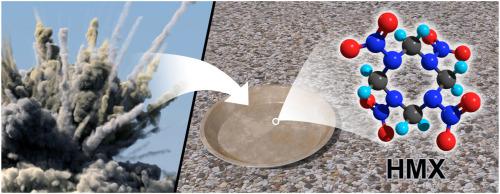Talanta ( IF 5.6 ) Pub Date : 2021-01-27 , DOI: 10.1016/j.talanta.2021.122124 Elizabeth H. Denis , Kelsey A. Morrison , Sonia Wharton , Shane Phillips , Stephen C. Myers , Michael P. Foxe , Robert G. Ewing

|
Explosives are often used in industry, geology, mining, and other applications, but it is not always clear what remains after a detonation or the fate and transport of any residual material. The goal of this study was to determine to what extent intact molecules of high explosive (HE) compounds are detectable and quantifiable from post-detonation dust and particulates in a field experiment with varied topography. We focused on HMX (1,3,5,7-Tetranitro-1,3,5,7-tetrazocane), which is less studied in field detonation literature, as the primary explosive material and RDX (1,3,5-Trinitroperhydro-1,3,5-triazine) as the secondary material. The experiment was conducted at Site 300, Lawrence Livermore National Laboratory's Experimental Test Site, in California, USA. Two 20.4 kg and one 40.8 kg above ground explosions (primarily comprised of LX-14, an HMX-based polymer-bonded high explosive) were detonated on an open-air firing area on separate days. The complex terrain of the firing area (e.g., buildings, berm, low-height obstacles) was advantageous to study HE deposition in relation to plume dynamics.
Three types of samples were collected up to 100 m away from each shot: surface swipes of aluminum plates, surface swipes of fixed objects, and filters from air samples. We used atmospheric flow tube-mass spectrometry (AFT-MS) to quantify picogram levels of molecular residue of HE material in the post-detonation dust. An aliquot of sample extract in methanol (e.g., 1 μL of 0.5 mL) was placed onto a resistive material and then thermally desorbed into the AFT-MS. We successfully detected and quantified both HMX and RDX in many of the samples. Based on mass (pg) detected and solution dilution, we back-calculated the mass collected on the swipe or filter (ng per sample). The aerial distribution of molecular residue was consistent with the path of the plume, which was strongly determined by wind speed and direction at the time of each shot. The quantity of material detected appeared to correlate more with distance from the shot and the wind conditions than with shot size. This study demonstrates that the picogram detection levels of AFT-MS are well-suited for quantification of analytes (e.g., HMX and RDX) in environmental samples.
中文翻译:

露天环境中爆炸后粉尘中痕量HMX和RDX的爆炸残留检测
炸药通常用于工业,地质,采矿和其他应用中,但并不总是清楚爆炸或任何残留物质的归宿和运输后还剩下什么。这项研究的目的是确定在具有不同地形的野外实验中,从爆炸后的粉尘和颗粒中可检测和定量的高爆炸性(HE)化合物完整分子的程度。我们将HMX(1,3,5,7-Tetranitro-1,3,5,7-tetrazocane)作为主要爆炸材料和RDX(1,3,5-Trinitroperhydro -1,3,5-triazine)作为辅助材料。该实验是在美国加利福尼亚州劳伦斯·利弗莫尔国家实验室的实验测试站点300上进行的。地面爆炸2起20.4千克,地面爆炸40.8千克(主要由LX-14,在另一天的露天射击区域引爆了一种基于HMX的聚合物键合高炸药。射击区域的复杂地形(例如建筑物,护堤,低矮的障碍物)有利于研究与羽流动力学有关的HE沉积。
距每次射击不超过100 m的地方收集了三种类型的样品:铝板的表面擦拭,固定物体的表面擦拭和空气样品的过滤器。我们使用大气流管质谱法(AFT-MS)来量化爆炸后粉尘中HE材料的分子残留的皮克级。将甲醇中的样品提取物等分试样(例如1μL的0.5 mL)放在电阻材料上,然后热脱附到AFT-MS中。我们成功地检测和定量了许多样品中的HMX和RDX。根据检测到的质量(pg)和溶液稀释度,我们反算了在滑动或过滤器上收集到的质量(每个样品ng)。残留分子的空中分布与羽流的路径一致,羽流的路径很大程度上取决于每次射击时的风速和风向。所探测到的材料数量似乎与离炮弹的距离和风况的关系更多,而不是与炮弹的大小相关。这项研究表明,AFT-MS的皮克检测水平非常适合定量环境样品中的分析物(例如HMX和RDX)。































 京公网安备 11010802027423号
京公网安备 11010802027423号